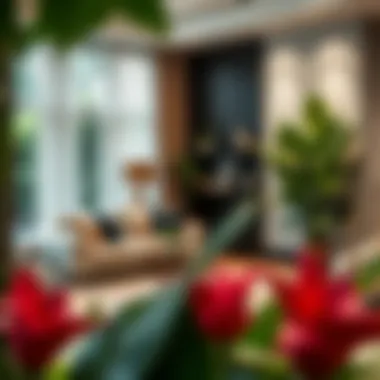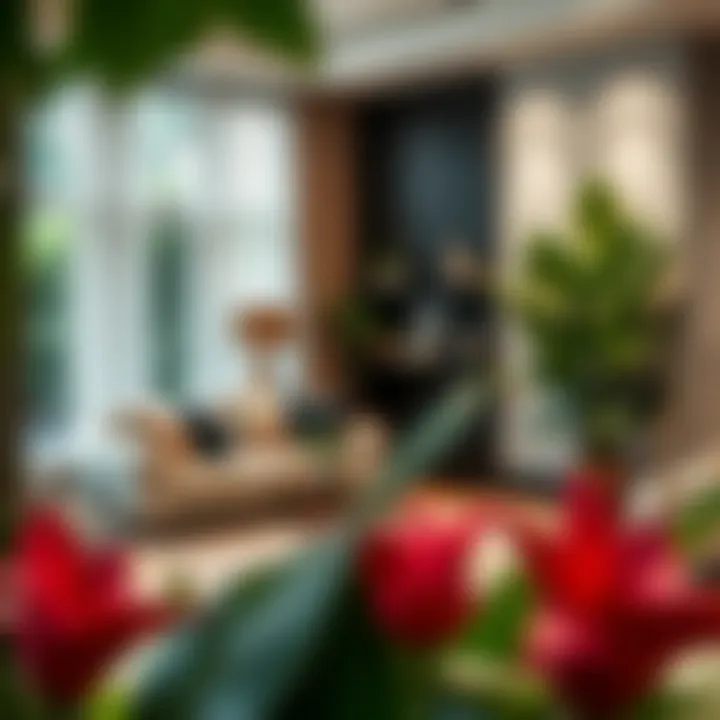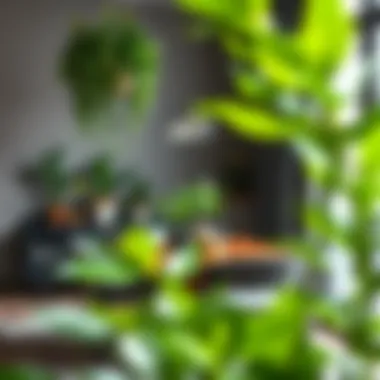Affordable Silk Plants: Elevate Your Home Decor


Intro
When it comes to sprucing up your living space, few things can bring as much transformative power as the right decorative elements. Among them, silk plants stand out for their blend of aesthetic appeal and practicality. Not everyone has a green thumb or the time to nurture real plants. Enter inexpensive silk plants, which offer a beautiful solution without the growing pains. They can complement any design style, from modern chic to classic elegance, while requiring minimal upkeep.
In this article, we’ll explore how these elegant pieces can enhance your home, laying out practical tips for selection and integration into various themes. Also, we’ll delve into the nuances of furniture design styles and how they mesh beautifully with silk flora.
Furniture Design Styles
Overview of Popular Styles
Navigating the world of interior design can sometimes feel like walking through a maze. Yet, understanding the basic furniture design styles can simplify your choices immensely. Here’s a breakdown of some genres that are currently hot in home decor:
- Modern: Characterized by clean lines, minimal ornamentation, and a neutral color palette. Silk plants here work to soften the sharp edges typical of modern design.
- Traditional: Rich fabrics and detailed woodwork define this style. A classic arrangement of silk plants can seamlessly enhance the grandeur often found in traditional interiors.
- Industrial: Think raw materials like metal and wood. Here, a pop of greenery through silk plants can break the harshness, introducing warmth into the space.
- Bohemian: This style embraces eclecticism and vibrant hues. Silk plants can add another layer of texture, harmonizing with various patterns and colors.
How to Mix and Match Styles
Mixing and matching styles can create an intriguing visual narrative in your home. By strategically placing silk plants, you can tie disparate elements together. For example, a modern coffee table accented with a classic silk arrangement creates contrast that draws the eye. Consider the following tips:
- Find Your Anchor: Decide on a dominant style; it will guide the rest of your choices.
- Use Silk Plants as Conversational Pieces: Choose silk plants that represent both styles. A tall, slender plant can highlight modernity while a richly textured one can nod towards traditional aesthetics.
- Balance: Always maintain a sense of balance. Too many overwhelming elements can make the space feel chaotic, while silk plants can help even out that imbalance.
"Harmonizing unique elements not only beautifies a space but can also speak to the personality of the homeowner."
Practical Tips for Homeowners
Essential Buying Tips
When purchasing silk plants, keep an eye on quality and realism. Here are some considerations to guide your buying journey:
- Material Matters: Make sure the leaves are made from durable material, like polyester, as they can mimic the texture of real leaves closely.
- Color Fidelity: Look for colors that are lifelike. While a bit of pop is welcome, you don’t want shockingly bright greens unless you're going for a unique statement.
- Sizing: Take note of the dimensions. A large plant can become a focal point, while smaller ones work better in clusters.
Maintenance and Care Guidelines
Though silk plants come with the advantage of low maintenance, a little care can go a long way in prolonging their appeal:
- Dust Regularly: A simple wipe with a damp cloth can keep them looking fresh.
- Store Properly: If you don’t plan to change up your decor often, store them in a dry place away from direct sunlight to prevent fading.
Finally, blending inexpensive silk plants into your home’s design approach can offer surprising advantages, combining both beauty and practicality without the major expense or time commitment involved with live plants. Taking the time to thoughtfully select and position these vibrant additions can make all the difference in creating an inviting atmosphere.
Understanding Inexpensive Silk Plants
In today's fast-paced world, where aesthetics are just as important as function, inexpensive silk plants have carved a niche for themselves. These decorative elements are more than mere substitutes for the real deal; they bring a range of advantages that many homeowners and decorators may not fully appreciate. Let’s explore why understanding silk plants is essential in interior design.
Definition and Characteristics
Silk plants, often crafted from synthetic materials that mimic real foliage, offer a lifelike appearance without the fuss of maintenance. They can be found in a plethora of styles, sizes, and colors, which makes them appealing to a wide audience. One notable characteristic is their durability; quality silk plants can withstand sunlight and moisture without fading, unlike their natural counterparts. Hence, they can easily thrive in areas where real plants would typically struggle, such as dimly lit spaces or rooms with fluctuating temperatures.
Another important aspect is their realism. Advances in manufacturing technology mean that silk plants often have intricate textures and vibrant colors, closely mimicking the look of alive foliage. To the untrained eye, a well-made silk ficus or hydrangea can easily pass for the real thing. This level of craftsmanship allows decorators to create stunning displays without the commitment of real plant care.
Comparing Natural and Silk Plants
When weighing the pros and cons, the comparison between natural and silk plants reveals several crucial factors. First off, while natural plants require regular watering, adequate sunlight, and even pest control, silk plants simply require a dusting every now and then.
- Lifespan: Natural plants have a finite lifespan, influenced by care and environment. Silk plants, however, can last for years without the risk of wilting, offering a long-term solution to home decor.
- Seasonal Display: Natural plants often come with the seasonal cycle—blooming in spring and going dormant in fall. Silk plants offer continuous blooms, allowing for vibrant displays year-round.
- Cost: In the short term, silk plants might seem like a splurge. However, considering their durability and longevity, they can be more cost-effective than continuously replacing natural plants that may wilt or die.


Ultimately, when thinking about home decor, the decision hinges on what you prioritize: the challenges of maintaining live plants, or the ease and longevity that silk alternatives provide. Embracing silk plants means not only simplifying your life but also enhancing the elegance of your space without the high price tag.
Advantages of Choosing Silk Plants
When it comes to enhancing the aesthetic quality of your space, silk plants offer numerous benefits that make them an attractive option for homeowners, decorators, and DIY enthusiasts alike. They bring a touch of nature indoors without the hassle of caring for real plants. Understanding the advantages of silk plants can help those looking to beautify their environments while enjoying practicality and elegance.
Low Maintenance and Durability
One of the standout features of silk plants is undoubtedly their low maintenance requirements. Unlike live plants, which may demand regular watering, pruning, and attention to soil conditions, silk plants are virtually hassle-free. These faux greenery options do not wilt, die, or need replacements on a seasonal basis, thus saving not only time but also energy.
Their durability is another significant asset. A well-crafted silk plant can endure years of use without losing its vibrancy or structure. Whenever dust begins to settle on the leaves, a simple wipe with a damp cloth revives their original luster. This ease of care makes silk plants suitable for busy individuals or families who may not have the time required to nurture live plants.
"Silk plants bring life to a space and require none of the TLC that real plants do, making them ideal for practical home lifers."
Allergy-Friendly Options
For many people, allergies can pose a considerable barrier to enjoying the natural beauty that live plants offer. Pollen is a common irritant that comes along with having real plants in the home. Silk plants provide a viable solution for those susceptible to allergies, as they do not produce pollen or release spores. This quality allows individuals to experience the beauty of nature indoors without the fear of triggering sneezing fits or exacerbating respiratory issues.
Additionally, silk plants also can be crafted from non-toxic materials, ensuring that homes with pets or young children remain safe and free from harm. For households with specific health concerns, this factor is crucial in making silk plants the best route toward home decor enhancement.
Cost-Effectiveness
When it comes to value for money, silk plants really shine. Though the initial investment may appear higher than that of real plants, the long-term benefits significantly outweigh the costs. Live plants often require purchasing soil, pots, plant food, and additional sunlight resources, all of which contribute to ongoing expenses.
Silk plants, on the other hand, offer a one-time cost without the need for further purchases. They remain beautiful and intact for years, delivering consistent beauty without the expenditure associated with the upkeep of living plants. In the world of interior design, where every dollar counts, the cost-effectiveness of silk plants makes them a leading choice for both budget-conscious and style-conscious individuals.
In essence, the appeal of silk plants encompasses their low maintenance nature, allergy-friendly attributes, and overall cost-effectiveness. These advantages create a compelling case for integrating silk plants into one’s living space, harmonizing elegance with practicality.
Selecting the Right Silk Plants
Choosing the right silk plants can be a game changer when it comes to decorating your space elegantly. Not only do these faux botanicals enhance the aesthetic appeal of your home, but they also provide versatility that natural plants simply cannot match. The key is to understand what varieties suit your taste and your environment.
Understanding Plant Varieties
Silk plants come in an array of varieties—each bringing its own character to a room. From the lush greenery of ferns to the structured elegance of succulents, it's essential to consider what vibe you want to convey. Understanding the type of plants available is fundamental.
- Foliage Plants: These are typically large and can dominate a space. Think of filling a corner with a silk fiddle leaf fig for a stylish statement.
- Flowering Plants: If you're after a pop of color, silk flowers can create that cheerful burst without the seasonal concerns.
- Seasonal Variations: Some silk plants mimic seasonal blooms. For instance, cherry blossoms can add a touch of spring, while evergreens can lend a cozy feel in winter.
Selecting the right variety means considering the overall theme of your decor. Too many mismatched types can create a cluttered look, while a cohesive selection enhances your space beautifully.
Assessing Size and Scale
When you select silk plants, keeping size and scale in mind is crucial. A massive arrangement in a small room can overpower the space, while tiny plants may get lost in large areas.
- Proportions Matter: Measure the area where you intend to place the plants. Taller plants work well in corners, while smaller varieties can grace shelves or tables. The key is to strike a balance that complements the shape and dimensions of your furniture and walls.
- Layering Heights: Mixing varying heights creates depth and interest. Use a tall silk palm next to shorter varieties like succulents to enhance visual appeal.
- Immediate Impact: Don't forget about the visual weight. A heavier-looking plant will make a stronger impact than a lighter one, which is important when assessing placement.
Color and Texture Considerations
The colors and textures of the silk plants can either harmonize with or contrast against your existing decor. For example, a soft greenery can provide a calming aura while vivid or patterned leaves might add a fun twist.
- Color Palette: Pay attention to the color scheme of your room. Selecting silk plants that reflect or complement your existing colors will create a sophisticated, cohesive look. Cool greens might work well in a neutral setting, while bright colors could energize a space.
- Texture Variations: Texture adds a layer of intrigue. Mixing smooth leaves with more textured varieties, like those mimicking a rough cactus, introduces a tactile experience that draws the eye.
"A well-placed silk plant can transform a dull space into a vibrant living area. It’s truly about making thoughtful selections."


In summary, selecting the right silk plants involves careful thought about the types available, their sizes, and the colors and textures that suit your space. By considering these factors, you create a harmonious, elegant environment that embodies both your style and functionality.
Integrating Silk Plants into Home Decor
Integrating silk plants into home decor can not only enhance the aesthetics of a space but also create a warm and inviting atmosphere. While natural plants often require a sunbeam-happy window and regular watering, silk plants bring a lot to the table without the high maintenance. They serve as an excellent alternative for those looking to add greenery to their environment without the fuss of caring for live plants.
In the world of interior design, the way you use colors, textures, and objects can completely transform a room’s vibe. Silk plants can play a crucial role in this transformation. They can be utilized to create a visual balance, add height to spaces, or simply improve the overall ambiance. The key is understanding how to seamlessly blend these elements into your existing decor.
This section will explore how to effectively integrate silk plants into your home by focusing on three main aspects: creating focal points, coordinating with different decor styles, and layering with other decorative elements.
Creating Focal Points
When it comes to decor, a focal point is something that draws the viewer’s eye. Silk plants are superb candidates for these statement pieces, particularly due to their vibrant colors and lifelike details.
- Size Matters: A towering silk tree or a large floral arrangement can command attention in a room. Placing such pieces in strategic locations, like near a fireplace or in an empty corner, helps to anchor the space.
- Contrasting Elements: Think about contrasting the lush greenery of silk plants against simpler furniture or wall colors. For instance, a rich green plant against white or beige walls creates a striking effect. Likewise, using bold patterns and colors in your surroundings can allow silk greenery to pop.
- Groupings: Arrange smaller silk plants in clusters of different heights and textures for added depth. Using a variety of pots or pedestals can also enhance this effect, making it feel more curated.
Silk plants can effectively establish a commanding presence in your decor when utilized thoughtfully.
Coordinating with Different Decor Styles
Silk plants are versatile enough to complement almost any decor style, be it modern, traditional, bohemian, or industrial. Understanding how to align the look of your silk plants with your overall theme is key.
- Modern Spaces: For sleek, contemporary homes, opt for minimalist plants like succulents or snake plants in simple, matte pots. A white or black container can enhance the modern feel.
- Rustic Charm: In a farmhouse setting, consider using silk plants in woven baskets or ceramic pots. Plants like lavender or wildflowers can enhance the natural vibe of rustic decor.
- Bohemian Flair: Overstuffed with colors? Use vibrant, exaggerated foliage and an eclectic collection of containers. Bright hues will resonate well with the carefree spirit of boho decor.
- Classic Elegance: For a more traditional space, select silk plants with classic shapes, such as topiaries in elegant urns. Their classic lines and forms will add an air of sophistication.
By carefully choosing types and placements, silk plants can seamlessly fit into any style of decor.
Layering with Other Decorative Elements
Layering is a vital technique in interior design; silk plants can serve to enhance this concept through the strategic mix of different decor elements.
- Textures: Combining silk plants with varied textures—such as soft textiles, wood, or metal—can create a well-rounded aesthetic. A silk plant next to a cozy armchair or knitted throw can provide a beautiful contrast.
- Height Variation: Consider using silk plants at various heights. While some on the floor can draw the eye downward, others on shelves or hangers can create a sense of verticality, guiding the viewer through the space.
- Mood Lighting: Integrating silk plants with lighting, like strategically placed lamps or string lights, can enhance the ambiance. The soft glow reflecting off the leaves of a silk pothos brings delightful warmth to a room.
Layering not only builds depth but also creates an intertwined story of textures and colors in your home decor, moving beyond mere surface aesthetics.
Silk plants are more than mere decorations; they are crucial ingredients in crafting an inviting and harmonious living space.
Thus, integrating silk plants into home decor is not just about positioning objects in a room, but rather about creating a narrative and experience that resonates with both the inhabitants and visitors.
Sourcing Inexpensive Silk Plants
Finding the right silk plants at an affordable cost is a vital part of creating a stunning space. The right choice can bring life to your home or office without requiring a deep dive into your wallet. Sourcing inexpensive silk plants is not just about searching for the lowest price, but also about understanding where quality meets affordability. This section delves into practical avenues for acquiring these decorative pieces, emphasizing the importance of both selection and cost-efficiency.
Online Retailers and Marketplaces
In the digital age, online retailers serve as rich veins for sourcing silk plants. Websites such as Amazon, Wayfair, and Etsy offer boundless choices. You can scroll through countless listings and find everything from delicate orchids to lush ferns. Shopping online allows you to compare prices effectively, read reviews, and sometimes even find unique artisanal pieces.
- Benefits of Online Shopping:
- Convenience: Shop from the comfort of your home.
- Variety: Access to a broader range of products.
- Customer Reviews: The ability to see feedback from previous buyers helps in making informed decisions.
However, be mindful of shipping costs. Sometimes the thrill of a good deal can be overshadowed by unexpected freight charges. To avoid this, check for promotions or bundles, as many retailers often run seasonal sales that can make an already great deal even better.
Local Stores and Craft Shops


Despite the convenience of online shopping, local stores and craft shops hold their unique appeal. Visiting a store in person allows you to experience the texture, weight, and color of the silk plants firsthand. Stores like Michael's or local garden centers often carry a variety of silk plants at decent prices. Deals can often be found during clearance sales, especially after holidays or seasonal changes.
- Pros of Local Shopping:
- Touch and Feel: Assessing quality is easier when you can handle the product.
- Support Local Business: Contributing to the local economy can be rewarding.
- Instant Gratification: You get your items immediately without waiting for shipping.
But beware! Sometimes, these stores might not have the extensive variety you're looking for. If you have specific plants in mind, it might take some digging around at a couple of different shops.
Second-hand Options and Thrift Stores
If you're a fan of unique finds, second-hand options and thrift stores might just be your cup of tea. You never know what treasures await in these often-overlooked shops. Places like Goodwill or local consignment shops can yield unexpected silk plants at a fraction of the cost you’d pay retail.
- Advantages of Thrifting:
- Unique Choices: You might discover vintage or rare pieces that can’t be found anywhere else.
- Budget-friendly: Prices can be remarkably low.
- Eco-Friendly: Reusing items is a sustainable choice.
It's a bit of a hunt, but for many, the thrill of the chase is half the fun. Just keep an eye out for quality, as some older decorations might look a bit worse for wear. A little DIY magic can transform them into stunning pieces worthy of any room.
By exploring these avenues—online retailers, local stores, or second-hand options—you can source silk plants that not only fit your budget but also elevate your space with elegance.
Maintaining Silk Plants
Keeping silk plants looking their best is a cornerstone of maximizing their aesthetic and functional value in your home. While these faux plants are heralded for their low maintenance nature, a bit of care goes a long way. Just like people, silk plants can be overlooked and need regular check-ups to keep them vibrant and appealing.
Cleaning Techniques
Silk plants, despite their artificial nature, accumulate dust and dirt over time. Proper cleaning ensures the plants remain eye-catching rather than dull. Here are some techniques:
- Dusting: Start with a soft cloth or feather duster to remove any loose dust. It's best to do this every couple of weeks. Make it a part of your regular cleaning routine so that they don't get too dirty.
- Washing: For a deeper clean, take a sink or tub with lukewarm water. Add a few drops of mild dish soap. Submerge the plants gently and use your hands to swish the water around. Rinse thoroughly to remove soap residue and allow them to air dry completely. Avoid direct sunlight, as this can cause fading.
- Toothbrush Method: For tight corners or delicate leaves, a soft toothbrush can work wonders. Gently brush along the veins and surfaces to dislodge dirt.
"A little regular care can make your silk plants seem fresh and lively, as if they were just picked from the garden."
Storage Tips for Longevity
When it comes time to store silk plants—whether for seasonal changes or during a move—keeping them in good condition is essential. Follow these strategies for best results:
- Clean Before Storing: Just like with your favorite coats before putting them away for the summer, give your silk plants a good clean. This prevents any dirt from damaging the materials over time.
- Use Original Packaging: If you still have the original packaging, there's nothing like it to keep the plants protected. If not, consider using a sturdy box or container, with ample cushioning—like bubble wrap or tissue paper.
- Avoid Humid Areas: Store your silk plants in a cool, dry place to avoid mold growth. Garages and basements might seem like a good idea, but moisture can wreak havoc.
- Check Regularly: Every few months, peek into your storage to ensure there’s no damage or deterioration. If you spot any wear and tear, you might want to consider a refreshing clean or even a light refurbish.
In summary, maintaining silk plants isn’t a chore; it’s an investment in aesthetics and longevity. Remember that the better you care for them, the longer they will bring charm and elegance to your living spaces.
Culmination
As we reach the end of our journey through the world of inexpensive silk plants, it’s clear that they offer a unique and practical approach to home decor. These artificial wonders not only provide an effortless way to introduce greenery into your space, but they also come with a variety of benefits that fit well into modern lifestyles.
First and foremost, choosing silk plants means embracing zero maintenance. Unlike their natural counterparts, silk plants don’t require watering, pruning, or sunlight to thrive. This quality is especially appealing for busy individuals or those who may not have a green thumb. You can have the beauty of a lush plant without any of the hassle. This ease contributes to a less stressful home environment.
Furthermore, allergy concerns often stem from real plants. The pollen and molds can wreak havoc on sensitive individuals, making silk plants an allergy-friendly choice. As a result, you can enjoy the aesthetics of plants without worrying about sneezing fits or itchy eyes.
Moreover, there’s the cost factor. Quality silk plants can be quite affordable, giving homeowners the chance to invest in decorative pieces without breaking the bank. High-impact décor is achievable with a modest budget, allowing for creativity to flourish without the financial burden.
Integrating silk plants into various decor styles is another significant advantage. They can effortlessly adapt to whatever theme you choose—whether that’s a minimalist look, a bohemian vibe, or even a sophisticated traditional space. Their versatility is a compelling reason to consider them, as they can enhance your home’s character and charm significantly.
"Inexpensive silk plants are not merely decorative; they're a thoughtful solution to elevate your environment while considering practicality."
Final Thoughts on Silk Plants
Silk plants are not merely an alternative to real plants; they symbolize a shift in how we view home decor. The ability to create an inviting atmosphere without the complexities that come with live plants makes them a worthy consideration for all. As you explore your options, keep in mind the significant advantages—ranging from their low maintenance needs to their budget-friendly nature. It’s important to choose wisely and select pieces that resonate with your personal style and space requirements.
In essence, the decision to furnish your home with inexpensive silk plants not only enhances the visual appeal but also echoes a lifestyle of convenience and sophistication. Allow yourself to experiment with various arrangements and styles; you just might uncover the perfect ornamentation that reflects your unique taste.















